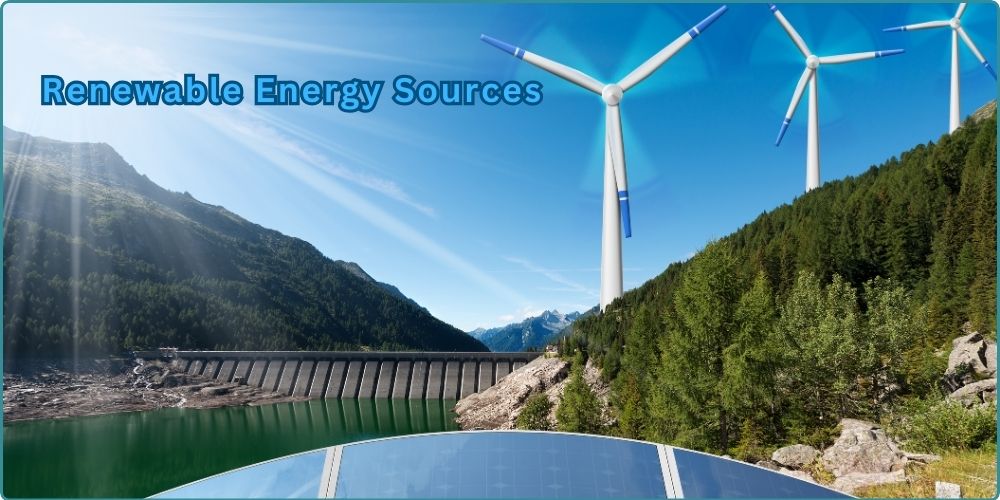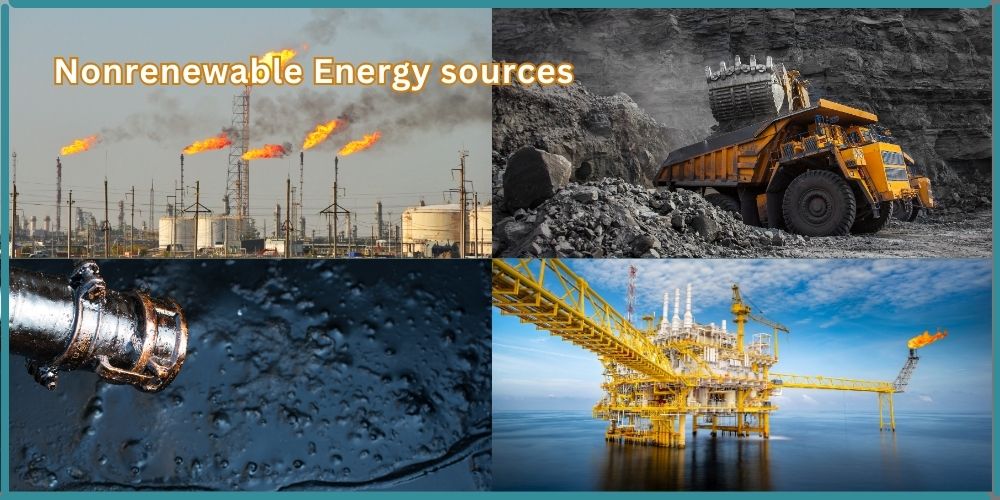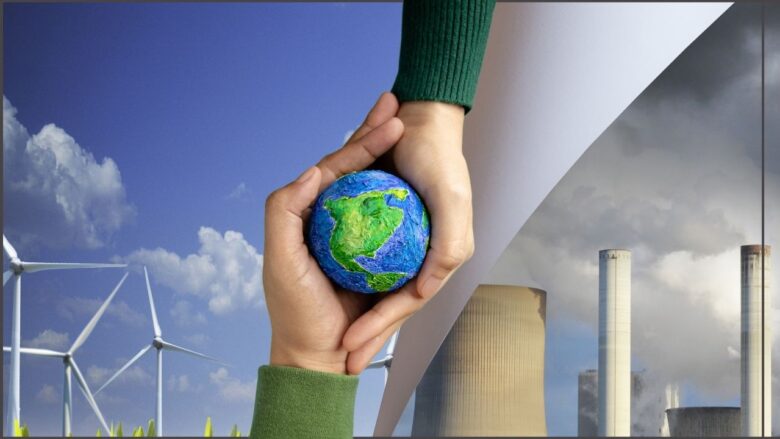Difference Between Renewable and Nonrenewable Energy Sources: Key Differences Explained
When we talk about energy, we often hear the terms “Renewable” and “Nonrenewable.” These two types of energy are quite different, and understanding them can help us make smarter choices for our planet’s future.
So, what is renewable energy? Naturally replenishable resources provide renewable energy. This includes things like sunlight, wind, and water. Picture this: using the sun’s rays to power your home. Or feeling the wind on a breezy day and knowing it can generate electricity. Cool, right? These abundant resources will not run out as long as we care for our environment.
On the other hand, nonrenewable energy comes from sources that can eventually run out. This includes fossil fuels like coal, oil, and natural gas. These energy resources originated deep inside the Earth over millions of years. When they are run out, they are lost forever. Using these fuels can also harm our planet by adding to pollution and climate change.
By getting to know these differences, you can make smart choices. Choices that help both you and our planet. Let’s look at what sets these two types of energy apart.
An Overview of the Difference Between Renewable and Nonrenewable Energy:
Energy is all around us, powering our homes, schools, and even our smartphones. But have you ever thought about where that energy comes from? Understanding different energy sources is important because they play a big role in our everyday lives. Let’s start with the basics of energy sources.
Importance Of Energy
Energy is like the unsung hero of our daily lives, quietly powering everything we do. From the moment we wake up to the sound of our alarm clock to how we unwind at night with our favourite shows, energy is behind it all. It fuels our homes, keeps our gadgets charged, and makes our commutes possible. Without energy, our world would come to a standstill. Energy is essential for progress and comfort. Its importance extends beyond mere convenience; energy drives economic growth, enhances productivity, and improves the quality of life.
Types Of Energy Sources
So, there are two big categories of energy sources: renewable and non-renewable. Renewable energy is generated from natural elements that can be restored over time, such as solar, wind, and hydropower. These sources are great for the environment because they don’t run out and help reduce pollution. For example, solar panels use sunlight to create electricity, while wind turbines capture the power of the wind.
On the other hand, non-renewable energy sources, such as coal, oil, and natural gas, come from materials that take millions of years to form. Once we use them up, they’re gone for good. While these sources provide a lot of energy quickly, burning them releases harmful gases into the air, contributing to climate change.
| Renewable Energy | Nonrenewable Energy |
|---|---|
Solar | Coal |
Wind | Oil |
Hydropower | Natural Gas |
Biomass | Nuclear |
Renewable Energy Explained
Naturally replenishable resources provide renewable energy. These energy sources are sustainable and will not run out. They help to reduce pollution and safeguard the environment. Let’s look at renewable energy and some of its common sources.

Definition Of Renewable Energy
Renewable energy comes from quickly replenished natural resources. It’s cleaner and better for the planet, as it never runs out and produces little to no pollution. They are always available and sustainable.
We can harness this energy from the sun, wind, water, and other sources. It offers a cleaner alternative to conventional energy sources. Renewable energy helps fight climate change. It reduces greenhouse gas emissions.
There are several common types of renewable energy. Each source has unique advantages and applications. Here are some of the most popular renewable energy sources:
- Solar Energy: Captured from sunlight using solar panels. It can power homes, businesses, and even cars.
- Wind Energy: Generated by wind turbines that convert wind into electricity. Wind farms can be found on land and offshore.
- Hydropower: Produced by harnessing the energy of flowing water. Dams and rivers are common locations for hydropower plants.
- Biomass: Derived from organic materials like plants and animal waste. Biomass can be used for heating, electricity, and fuel.
- Geothermal Energy: Comes from the heat stored within the Earth. It is used for electricity generation and direct heating purposes.
These renewable energy sources offer a sustainable way to meet our energy needs. By relying on these sources, we can protect our planet and ensure a cleaner future.
Nonrenewable Energy Explained
Nonrenewable energy is sourced from things that will eventually run out or won’t be replaced during our lifetimes. Renewable energy is produced through natural processes that keep getting refreshed. What sets them apart is sustainability and how they are generated.

Definition Of Nonrenewable Energy
Nonrenewable energy is energy from sources that will run out. It does not have long-term sustainability, and once used, it proves difficult to replace. Hence, we’re using them up quicker than nature can bring them back.
Common Nonrenewable Sources
Common nonrenewable sources include coal, oil, and natural gas. These are fossil fuels. Another source is nuclear energy, and it comes from uranium. Coal is a black or brown rock. Oil is a liquid fossil fuel. We burn oil to generate electricity and make petrol and other products. Natural gas, found underground, is another fossil fuel. People use it for heating and electricity. Nuclear energy, however, comes from splitting uranium atoms. This process, done in nuclear power plants, releases vast amounts of energy. Once people use them up, they are gone forever.
Key Differences Between Renewable and Nonrenewable Energy Sources
It’s essential to understand the key differences between renewable and nonrenewable energy. These differences affect our environment, economy, and future energy sources. Let’s take a closer look at the main differences based on availability and environmental impact.
Renewable Resources | Non-renewable Resources |
Depletion | |
| Renewable resources sources are abundant and cannot be run out over time.
| Nonrenewable resources are limited and diminish with time.
|
Sources | |
| Renewable resources are things like solar, wind, hydro power, and even geothermal sources like hot springs and fumaroles.
| Non-renewable resources include things like fossil fuels, which are coal, petroleum, natural gas, nuclear energy.
|
Impact on Environment | |
| Most renewable resources tend to have low carbon emissions and they produce little to no greenhouse gases. This helps reduce global warming and pollution.
| Nonrenewable energy sources, on the other hand, contribute significantly to environmental pollution. Burning fossil fuels releases harmful pollutants and greenhouse gases. This leads to climate change and health problems.
|
Cost | |
| Renewable energy can be pricey at first. For example, producing electricity with renewable energy technologies tends to be more expensive than using fossil fuels. | Non-renewable energy tends to have a lower initial cost.
|
Infrastructure Requirements | |
| Setting up the infrastructure to harvest renewable energy can be really costly and isn’t something that’s easily available in many countries.
| Most countries have infrastructure for non-renewable energy that’s both cost-effective and accessible.
|
Area Requirements | |
| It needs a pretty big piece of land or even some offshore space, particularly for wind and solar farms.
| It needs less space compared to others.
|
Advantages Of Renewable Energy
Every day, when the sun comes up, it provides us with an incredible source of energy that we can use for renewable purposes. Imagineing the wind’s gentle breeze or the sun’s warm rays to power our homes and schools. This shift towards renewable energy isn’t just a trend; it’s a game changer for our planet and future.
Sustainability
Renewable energy sources are sustainable. Renewable energy sources, such as water, solar, or wind power, come from natural processes that are constantly replenished. For example, the sun will shine, and the wind will blow. This means we can rely on these sources for long-term energy. Unlike fossil fuels, renewable sources do not deplete, making them a reliable choice for future generations. Using renewable energy helps preserve natural resources and ensures energy security.
Reduced Emissions
Renewable energy produces minimal greenhouse gas emissions, which is a great way to combat climate change. For example, solar and wind energy produce electricity without the need to burn fossil fuels. This cuts down on the carbon dioxide that gets released into the atmosphere.
When we lower emissions, we get cleaner air and a healthier environment. This also means there are fewer health problems, such as asthma and other breathing issues. Using renewable energy helps us build a cleaner, healthier world.
Economic Benefits
The benefits of using renewable energy go beyond just saving the Earth—they also touch our daily lives in meaningful ways. Switching to renewable energy can lead to amazing advantages, from boosting our economy to providing us with a steady source of power. When we invest in clean energy sources like solar and wind, we create jobs that help families and communities grow.
Plus, renewable energy resources are unlimited. Hence, it is a popular choice for a sustainable future.
Advantages Of Nonrenewable Energy
For decades, society has relied on nonrenewable energy sources like natural gas, coal, and oil. These sources provide the electricity that lights our homes, fuels our cars, and powers our industries. Many of the conveniences we enjoy today wouldn’t be possible without them. But what are the real advantages of nonrenewable energy? For starters, these sources are often more reliable and efficient than their renewable counterparts. They can consistently produce large amounts of energy day or night, rain or shine.
Reliable Energy Source
Nonrenewable energy sources can generate energy consistently, whether it’s day or night. These sources offer a stable power supply, so you can count on them for your home or business. Unlike some renewable sources, nonrenewable energy isn’t affected by weather changes.
High energy density
Nonrenewable energy sources are powerful, packing a lot of energy into a small amount of material. So, we can produce a ton of power using just a little bit of fuel. High energy density helps us keep up with the needs of our growing populations and industries.
Economic Benefits
Nonrenewable energy sources are often cheaper to extract and use in the short term. Many jobs are created in the extraction, refining, and distribution sectors. Stable energy prices from nonrenewable sources can help boost local economies.
Established Infrastructure
We already have a lot of infrastructure for extracting and using nonrenewable energy. It’s often quicker and cheaper to use existing infrastructure than to build new renewable energy systems.
Technological Advances
New innovations in extracting and using nonrenewable energy have improved its cleanliness and efficiency.
Have you noticed how new technologies are reducing pollution and making energy production safer? It’s pretty cool!
Continued research can make nonrenewable energy even more beneficial in the future.
It’s really important to recognize how crucial it is to move towards renewable energy, but we also need to highlight the role of nonrenewable sources in our current energy landscape.
Challenges Of Renewable Energy
Renewable energy is super important for a sustainable future. Yet, it faces challenges. These challenges can slow down its adoption. Let’s explore some major challenges.
Intermittency
One of the biggest hurdles is the inconsistency of solar and wind power resources. The sun doesn’t shine at night. The wind doesn’t always blow. This creates gaps in energy supply, making it hard to depend on these energy sources all the time. To solve this, we need better energy storage. Batteries and other technologies can help, but they are still developing, which means renewable energy can be unreliable.
High Initial Costs
High initial costs are another challenge. Setting up renewable energy systems costs a lot. Solar panels and wind turbines are expensive. Additionally, finding places to set up solar panels and wind turbines can be tough, especially in crowded areas. So is the technology to store energy. Finally, there’s the need for better energy storage solutions to keep power available when it’s needed most. These challenges can feel overwhelming, but they are essential to tackle as we move toward a cleaner energy future.
Government incentives can help. However, not all regions have these incentives. This makes it hard for many to switch to renewable energy. Over time, costs may go down. But right now, they are high.
Challenges Of Nonrenewable Energy
Nonrenewable energy sources pose several challenges. These challenges impact the environment, economy, and society. Understanding these issues is crucial for a sustainable future.
Resource Depletion
When we talk about nonrenewable energy sources, we’re looking at things like coal, oil, and natural gas. One big issue is that these resources are limited and will eventually run out, meaning we need to find alternatives soon. The more we use, the less we have. This scarcity drives up costs. It also creates energy insecurity. Future generations may face shortages. This dependence is risky and unsustainable.
Pollution
Nonrenewable energy sources cause significant pollution. Burning fossil fuels emits toxic gasses into the earth’s atmosphere. These include carbon dioxide and sulfur dioxide. This adds to air pollution and climate change. They also cause acid rain. This pollution harms human health. It leads to respiratory issues and other diseases. Water and soil can also get contaminated. This affects wildlife and ecosystems. There’s also the risk of oil spills and accidents that can damage the environment. Relying on these sources puts us in a tough spot, urging us to seek cleaner, renewable options for a better tomorrow.
Future Of Energy
We’re genuinely at a turning point regarding the future of energy. With everyone looking for sustainable solutions these days, it’s crucial to understand the difference between renewable and nonrenewable energy. Renewable energy sources, like water, solar, and wind, offer an endless supply. Coal and oil are examples of nonrenewable energy sources that are limited and harmful to the environment.
Technological Innovations
Technological advancements are influencing the future of energy. Solar panels are becoming increasingly efficient, wind turbines are producing more power, and battery storage technology is improving. These advancements increase access to renewable energy, save costs, and improve efficiency.
Policy And Regulation
Policies and regulations are super important for shaping the future of energy. Governments are aiming for more renewable energy use, cutting back on fossil fuel subsidies, and increasing tax incentives for renewable projects. These policies really promote investing in renewable energy and play a big role in reduce greenhouse gas emissions.
Conclusion
Renewable and nonrenewable energy sources have distinct differences. It’s clear that the choices we make today will shape our world tomorrow. Infinite and beneficial for our world are renewable energy sources include solar and wind power. In contrast, nonrenewable energy sources like coal and oil can run out and harm the environment. By choosing renewable options, we can make a cleaner, healthier future for ourselves and future generations. Understanding these differences is important to make informed and intelligent energy choices that benefit everyone.
Frequently Asked Questions
What Are Examples Of Renewable Energy?
Some examples are solar, wind, hydro, geothermal, and biomass energy.
What is the importance of Renewable Energy?
It reduces pollution, slows climate change, and provides sustainable energy.
What Are Nonrenewable Energy Sources?
Nonrenewable sources include coal, oil, natural gas, and nuclear energy.
How Do Renewable And Nonrenewable Energy Differ?
Renewable energy is sustainable and replenishes naturally. Nonrenewable energy depletes and can harm the environment.
Is Renewable Energy More Expensive?
The upfront costs can be high, but long-term savings and environmental benefits are significant.


This blog does a great job explaining the difference between renewable and nonrenewable energy in a way that’s easy to understand. It’s perfect for anyone who wants to learn how energy impacts our planet. If you’re curious about sustainable choices, I highly recommend reading this!
Such a clear and engaging explanation of renewable vs. nonrenewable energy! This blog simplifies a vital topic for everyone to understand. If you’re curious about how energy choices impact our planet and future, this is a must-read. Great work, and highly recommended!